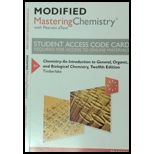
Concept explainers
Identify each activity, a to f as an observation, a hypothesis, an experiment, or a conclusion.
Lucia wants to develop a process for dyeing shirts so that the color will not fade when the shirt is washed. She proceeds with the following activities:
a. Lucia notices that the dye in a design fades when the shirt is washed.
b. Lucia decides that the dye needs something to help it combine with the fabric.
c. She places a spot of dye on each of four shirts and then places each one separately in water, salt water, vinegars and baking soda and water.
d. After one hour, all the shirts are removed and washed with a detergent.
e. Lucia notices that the dye has faded on the shirts in water, salt water, and baking soda, whereas the dye did not fade on the shirt soaked in vinegar.
f. Lucia thinks that the vinegar binds with the dye so it does not fade when the shirt is washed.
Want to see the full answer?
Check out a sample textbook solution
Chapter 1 Solutions
Modified MasteringChemistry with Pearson eText -- Standalone Access Card -- for Chemistry: An Introduction to General, Organic, and Biological Chemistry (12th Edition)
- Define the terms experiment and theory. How are theory and experiment related? What is a hypothesis?arrow_forward1.15 We used the example of attendance at a football game to emphasize the nature of observations. Describe another example where deciding how to count subjects of interest could affect the observation.arrow_forward1.21 When a scientist looks at an experiment and then predicts the results of other related experiments, which type of reasoning is she using? Explain your answer.arrow_forward
- What is wrong with this statement? "The results of the experiment do not agree with the theory. Something must be wrong with the experiment."arrow_forwardIn my on-campus Organic Chemistry II Lab, my students make aspirin. The melting point in the literature for aspirin is 134-136°C. Suppose the sample of aspirin one of my students made has a melting point range of 129-133 °C. Using this information, answer the following: 1. Do you think the student made aspirin? Why or why not? 2. How could you test your hypothesis? Explain what you would do and what the results would look like if they made aspirin versus if they didn't.arrow_forward1.90 A calibrated flask was filled to the 25.00-mL mark with ethyl alcohol and was found to have a mass of 19.7325 g. In a second experiment, 25.0920 g of metal beads were put into the container and the flask was again filled to the 25.00-mL mark. The total mass of the metal plus the alcohol was 43 .0725 g. Describe how to determine the density of the metal sample.arrow_forward
- Some scientists think the extinction of the dinosaurs was due to a collision with a large comet or meteor. Is this statement a hypothesis or a theory? Justify your answer.arrow_forwardConsider multiplying “26.2” by “16.43.” What would a mathematician say the answer is? What would a scientist say? Justify the scientist’s answer, not merely citing the rule, hut explaining it.arrow_forwardHow can a liquid be distinguished from a fine powder? What type of experiment or observation might be undertaken?arrow_forward
- 1.18 Two golfers are practicing shots around a putting green. Each golfer takes 20 shots. Golfer 1 has 7 shots within 1 meter of the hole, and the other 13 shots are scattered around the green. Golfer 2 has 17 shots that go into a small sand trap near the green and 3 just on the green near the trap. Which golfer is more precise? Which is more accurate?arrow_forward1.71 Is touch screen technology better described as a single design or as a more complex system? Explain your answer.arrow_forwardConsider the addition of “1 5.4” to “28.” What would a mathematician say the answer is? What would a scientist say? justify the scientist’s answer, not merely citing the rule, but explaining it.arrow_forward
 ChemistryChemistryISBN:9781305957404Author:Steven S. Zumdahl, Susan A. Zumdahl, Donald J. DeCostePublisher:Cengage Learning
ChemistryChemistryISBN:9781305957404Author:Steven S. Zumdahl, Susan A. Zumdahl, Donald J. DeCostePublisher:Cengage Learning
 World of Chemistry, 3rd editionChemistryISBN:9781133109655Author:Steven S. Zumdahl, Susan L. Zumdahl, Donald J. DeCostePublisher:Brooks / Cole / Cengage Learning
World of Chemistry, 3rd editionChemistryISBN:9781133109655Author:Steven S. Zumdahl, Susan L. Zumdahl, Donald J. DeCostePublisher:Brooks / Cole / Cengage Learning Chemistry for Engineering StudentsChemistryISBN:9781337398909Author:Lawrence S. Brown, Tom HolmePublisher:Cengage Learning
Chemistry for Engineering StudentsChemistryISBN:9781337398909Author:Lawrence S. Brown, Tom HolmePublisher:Cengage Learning Chemistry: The Molecular ScienceChemistryISBN:9781285199047Author:John W. Moore, Conrad L. StanitskiPublisher:Cengage Learning
Chemistry: The Molecular ScienceChemistryISBN:9781285199047Author:John W. Moore, Conrad L. StanitskiPublisher:Cengage Learning





